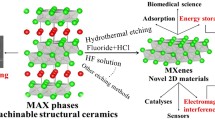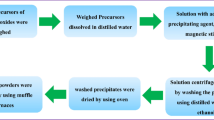Abstract
Rock salt structured Li4WO5 ceramics were prepared by the reaction sintering method. Without calcination, a mixture of Li2CO3 and WO3 were sintered directly. XRD shows that a single orthorhombic Li4WO5 phase was obtained throughout the sintering temperature range 870–910 °C. Dense ceramic with a high relative density ~ 94.2% was achieved through reaction sintering at 880 °C. Excellent microwave properties with ε r = 9.1, Q × f = 43,000 GHz, and τ f = − 3 ppm/°C were obtained. In contrast with the conventionally sintered ceramics, it should be noted that the reaction sintered samples have a higher permittivity and quality factor. These results show that the reaction sintering can enhance the densification of Li4WO5, which in turn would improve the dielectric performances.




Similar content being viewed by others
References
M. Makimoto, S. Yamashita, Microwave Resonators and Filters for Wireless Communication: Microwave Resonators and filters for Wireless Communication: Theory, Design and Application. (Springer, Berlin, 2001)
M.T. Sebastian, Dielectric Materials for Wireless Communication. (Elsevier, Oxford, 2015)
L. Zhang, Z.X. Yue, L.T. Li, Ceramic-polymer composites with low dielectric loss for microwave antennas and wireless sensors. Key Eng. Mater. 655, 153–158 (2015)
C.C. Li, H.C. Xiang, Y. Tang, M.Y. Xu, J. Khaliq, J.Q. Chen, L. Fang, Low-firing and temperature stable microwave dielectric ceramics: Ba2LnV3O11 (Ln = Nd, Sm). J. Am. Ceram. Soc. 101, 773–781 (2018)
H. Li, W. Lu, W. Lei, Microwave dielectric properties of Li2ZnTi3O8 ceramics doped with ZnO–B2O3 frit. Mater. Lett. 71, 148–150 (2012)
L. Sebastian, J. Gopalakrishnan, Li2MTiO4 (M = Mn, Fe, Co, Ni): new cation-disordered rock salt oxides exhibiting oxidative deintercalation of lithium. Synthesis of an ordered Li2NiTiO4. J. Solid State Chem. 172, 171–177 (2003)
J.J. Bian, Microwave dielectric properties of the lithium containing compounds with rock salt structure. Ferroelectrics. 387, 123–129 (2009)
Y.W. Tseng, J.Y. Chen, Y.C. Kuo, C.L. Huang, Low-loss microwave dielectric using rock salt oxide Li2MgTiO4. J. Alloys Compd. 509, L301–L310 (2011)
J.J. Bian, Y.F. Dong, Sintering behavior, microstructure and microwave dielectric properties of Li2 + xTiO3 (0 ≤ x ≤ 0.2). Mater. Sci. Eng. B. 176, 147–151 (2011)
L.X. Pang, H. Liu, D. Zhou, J.X. Yang, D.J. Li, W.G. Liu, Low-temperature sintering and microwave dielectric properties of Li3MO4 (M = Ta, Sb) ceramics. J. Alloys Compd. 43, 22–24 (2012)
J. Li, L. Fang, H. Luo, J. Khaliq, Y. Tang, C.C. Li, Li4WO5: a temperature stable low-firing microwave dielectric ceramic with rock salt structure. J. Eur. Ceram. Soc. 36, 243–246 (2016)
J. Bi, Y. Niu, H. Wu, Li2Mg3Ti2O9: a novel low-loss microwave dielectric ceramic for LTCC applications. Ceram. Int. L1, 7522–7530 (2017)
W.C. Tsai, Y.H. Liou, Y.C. Liou, Microwave dielectric properties of MgAl2O4 –CoAl2O4 spinel compounds prepared by reaction-sintering process. Mater. Sci. Eng. B. 177, 1133–1137 (2012)
Y.C. Liou, Y.L. Sung, Preparation of columbite MgNb2O6 and ZnNb2O6 ceramics by reaction-sintering. Ceram. Int. 34, 371–377 (2008)
Y. Zhao, P. Zhang, Preparation for ultra-low loss dielectric ceramics of ZnZrNb2O8 by reaction-sintering process. J. Alloys Compd. 672, 630–635 (2016)
X. Lu, Y. Zheng, Z. Dong, W. Zhang, Q. Huang, Microstructures and microwave dielectric properties of Li2ZnTi3O8 ceramics prepared by reaction-sintering process. J. Mater. Sci. 25, 3358–3363 (2014)
B.W. Hakki, P.D. Coleman, Method of Measuring Inductive Capacities in the Millimeter range, IRE Trans. Microw. Theory Tech., MTT-8 (1960) pp. 402–410
P. Moradi, E. Taheri-Nassaj, H. Taghipour-Armaki, Effect of zinc ions non-stoichiometry on the microstructure and microwave dielectric properties of Li2ZnTi3O8 ceramics. J. Alloys Compd. 695, 3772–3778 (2017)
Y.C. Liou, J.H. Chen, H.W. Wang, C.Y. Liu, Synthesis of (Ba x Sr1–x)(Zn1/3Nb2/3)O3 ceramics by reaction-sintering process and microstructure. Mater. Res. Bull. 41, 455–460 (2006)
S.J. Penn, N.M. Alford, A. Templeton, X. Wang, M. Xu, M. Reece, Effect of porosity and grain size on the microwave dielectric properties of sintered alumina. J. Am. Ceram. Soc. 80, 1885–1888 (1997)
J.J. Bian, J.Y. Wu, L. Wang, Structural evolution, sintering behavior and microwave dielectric properties of (1–x)Li3NbO4–xLiF (0 ≤ x ≤ 0.9). J. Eur. Ceram Soc. 32, 1251–1259 (2012)
C.L. Huang, S.H. Liu, Low loss microwave dielectrics in the (Mg1–xZn x )TiO4 ceramic. J. Am. Ceram. Soc. 91, 3428–3430 (2008)
Acknowledgements
This work was supported by Natural Science Foundation of China (Nos. 51502047, 21561008, and 21761008), the Natural Science Foundation of Guangxi Zhuang Autonomous Region (Nos. 2015GXNSFFA139003, 2016GXNSFBA380134, and 2016GXNSFAA380018), Project of Scientific Research and Technical Exploitation Program of Guilin (2016010702-2, 20170225), and Innovation Project of Guangxi Graduate Education (YCBZ2017052). Chunchun Li gratefully acknowledges the Guangxi Scholarship Fund of Guangxi Education Department.
Author information
Authors and Affiliations
Corresponding author
Rights and permissions
About this article
Cite this article
Xiao, K., Li, C., Xiang, H. et al. Reaction sintering of a rock salt structured Li4WO5 ceramic and its microwave dielectric properties. J Mater Sci: Mater Electron 29, 6397–6402 (2018). https://doi.org/10.1007/s10854-018-8619-x
Received:
Accepted:
Published:
Issue Date:
DOI: https://doi.org/10.1007/s10854-018-8619-x




